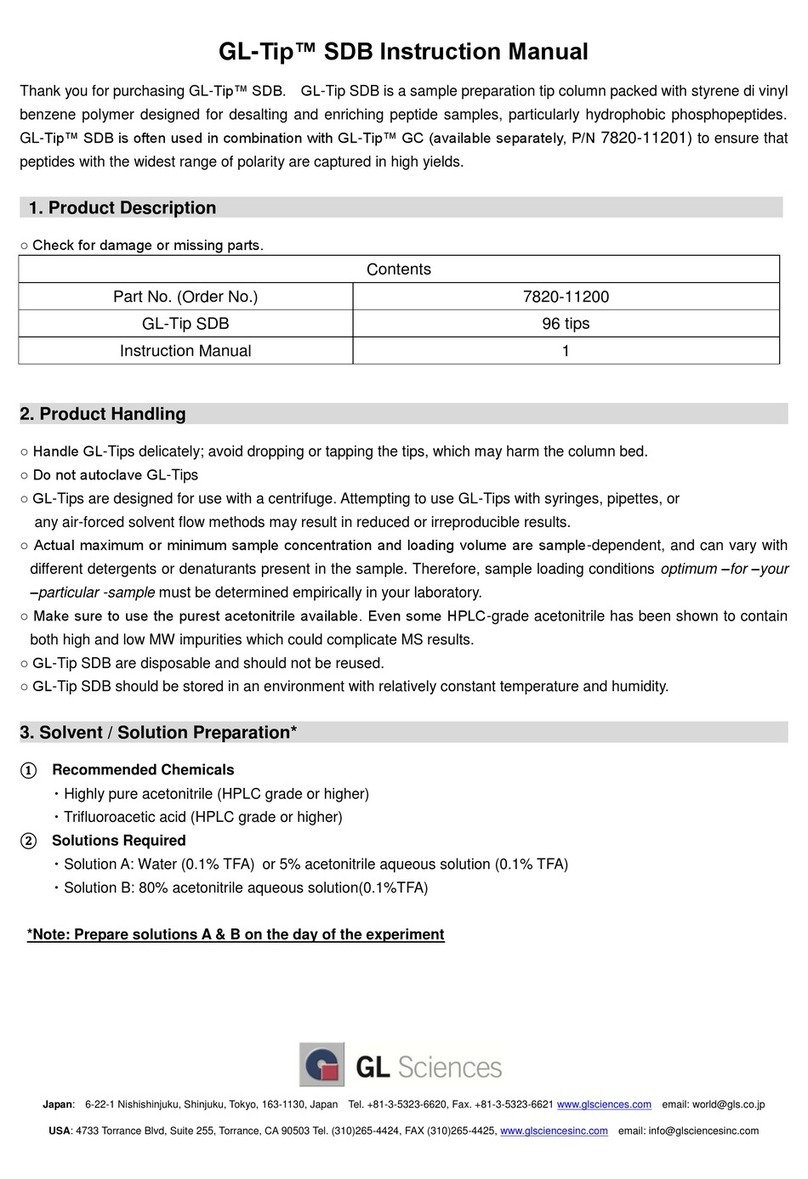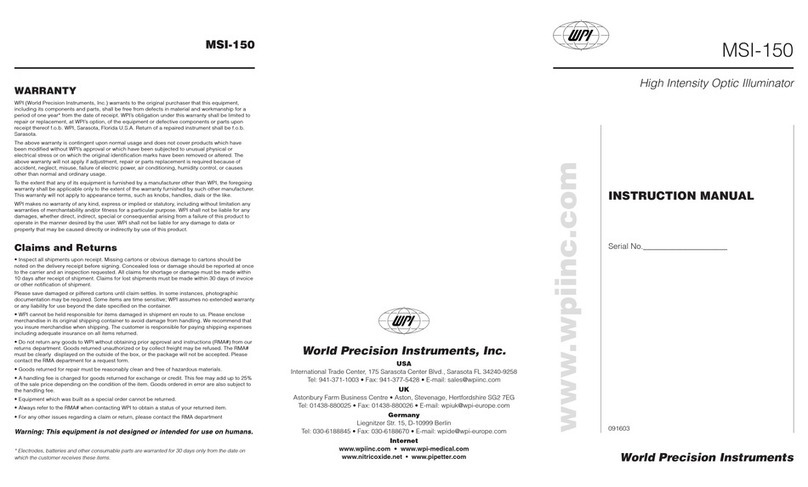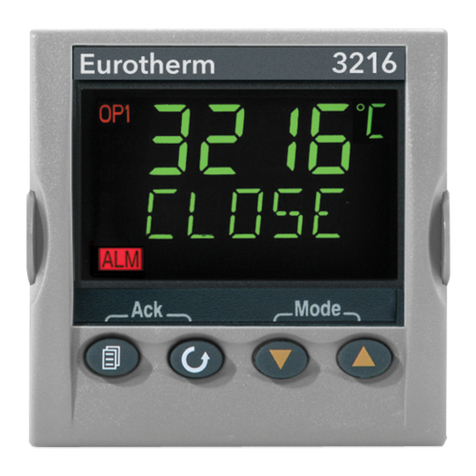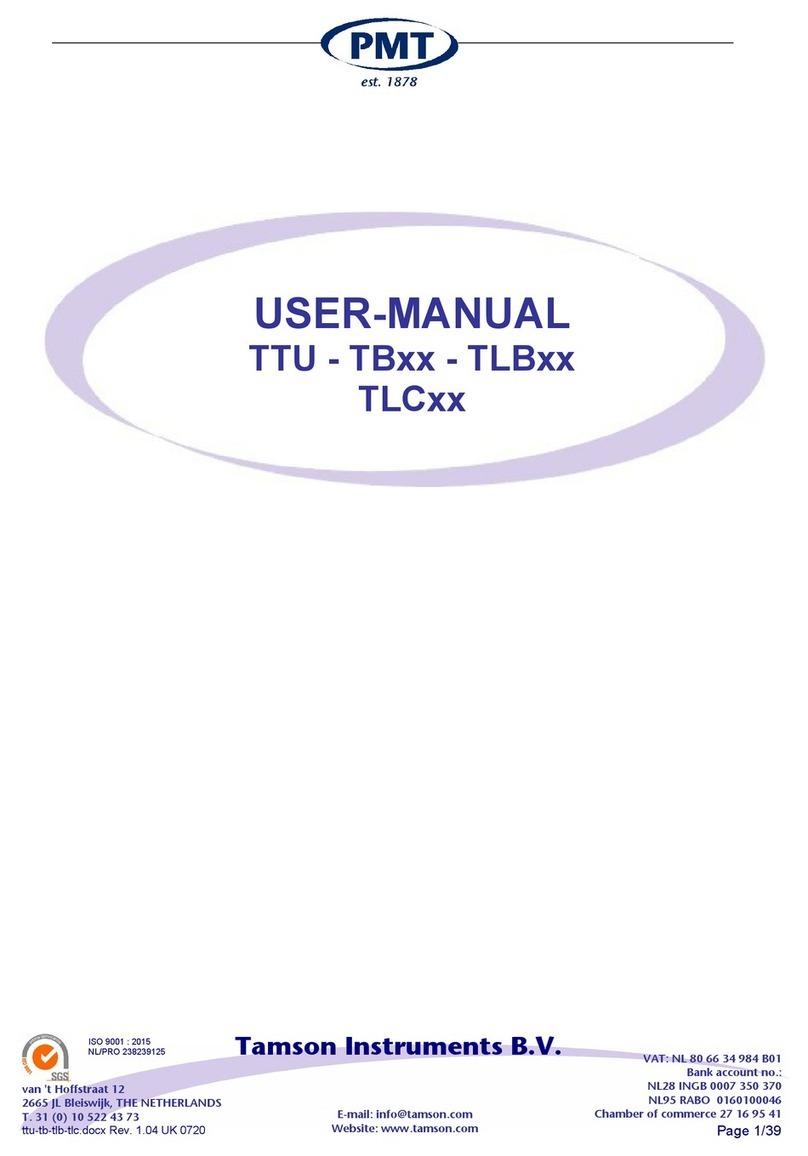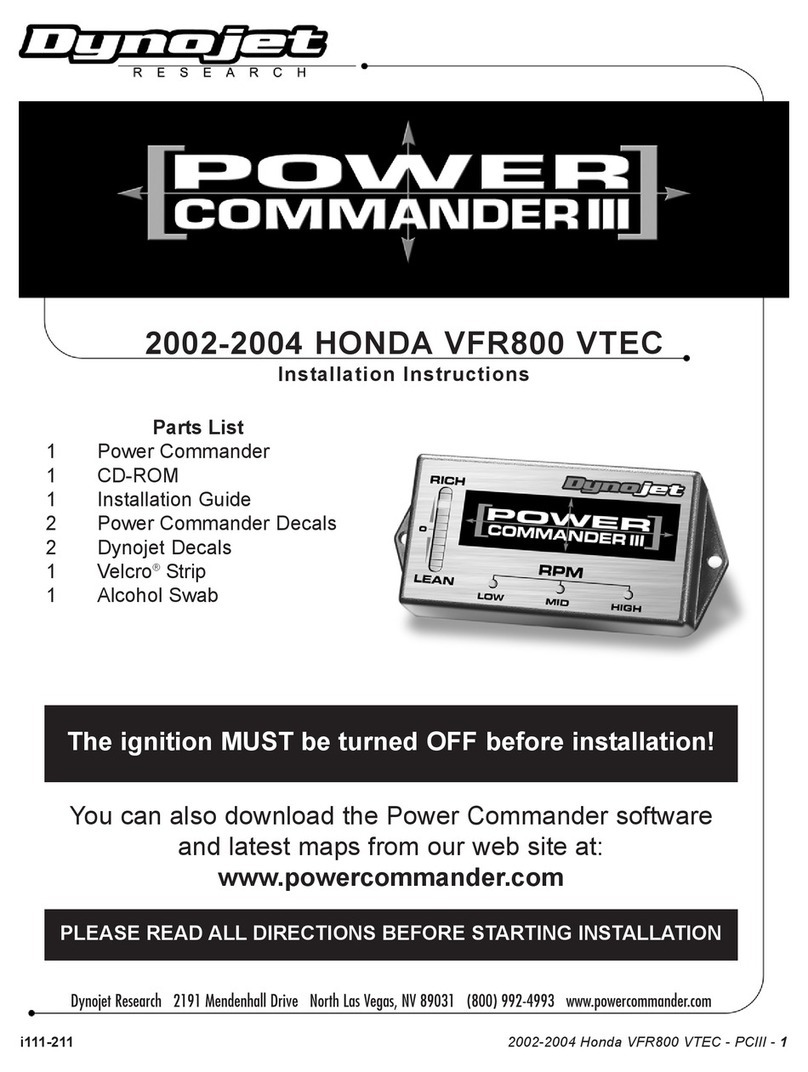GL Sciences OPTIC-4 User manual

OPTIC-4Multimode GC Inlet
User’s Guide:
Installation and
Operation

OPTIC-4 User’s Guide
Issue 5.3
Disclaimer & Copyright
Page i
Disclaimer
GL Sciences B.V. makes no representations or warranties with respect to the contents or use of this
manual and specifically disclaims any express or implied warranties of merchantability or fitness for
any particular purpose. Further GL Sciences B.V. reserves the right to revise this manual and to
make changes to its content at any time, without obligation to notify any person or entity of such
revisions or changes. The instruments are similarly subject to change without notice.
Copyright
No part of this manual may be reproduced or transmitted in any form or by any means, electronic or
mechanical, including photocopying and recording, for any purpose other than the purchaser's
personal use without the written consent of the copyright holder.
GL Sciences B.V., 2011-2018. All rights reserved.
GL Sciences B.V.
De Sleutel 9
5652 AS Eindhoven
The Netherlands
Telephone: +31 (0)40 254 95 31
E-mail: [email protected]
Web site: www.glsciences.eu

OPTIC-4 User’s Guide
Issue 5.3
Revision History
Page ii
Revision History
Document Number: 2406-8001
Date
Issue
Description
01-04-2011
1.0
Initial issue
18-06-2012
2.0
Sections 1.5 and 4.7.3 are changed. Some errors and omissions are corrected.
02-08-2012
2.1
Appendix E (Liner Selection Guide) are revised.
15-03-2013
2.2
Chapter 4, Appendices E and F are revised.
20-06-2013
3.0
Section 4.7, Appendix E are revised.
10-09-2013
3.1
CE Declaration of Conformity are revised.
29-10-2013
3.2
Some sections and Appendices C and F are revised.
02-07-2014
4.0
Company name changed, section 4.6 is revised.
24-08-2015
4.1
Appendices C and F are revised.
29-10-2015
4.2
Section 11.2 and Appendix F are revised.
23-11-2015
4.3
Chapters 4, 5 and 12, Appendix A are revised.
27-07-2016
5.0
Chapter 1 translated to Chinese, sections 7.5, 11.3 and 11.4 are revised.
23-01-2017
5.1
Chapter 2, 4, 11 and Appendix F are revised.
13-04-2017
5.2
CE Declaration and Appendix F are revised.
18-06-2018
5.3
Section 4.7 and Appendix E are revised.

OPTIC-4 User’s Guide
Issue 5.3
Declaration of Conformity
Page iii
CE Declaration of Conformity
Manufacturer: GL Sciences B.V.
De Sleutel 9, 5652 AS Eindhoven, The Netherlands
Tel: +31 (0)40 254 95 31
www.glsciences.eu, inf[email protected]
Product: OPTIC-4, all models
Type of Equipment: Multimode GC Inlet System
Application of Council
Directives: 2014/35/EC (Low Voltage Directive)
2014/30/EC (EMC Directive)
Certification Body: Dijkstra Advies, Research & EMC Consultancy B.V.,
Woerden, The Netherlands
Product compliant to: EN 61010-1 (2010)
EN 61326-1 (2013) Class B
EN 61326-1 (2013) Basic
EN 61000-3-2 (2014)
EN 61000-3-3 (2013)
Certificates: Certificates of Conformity to Low Voltage Directive No.
11C00201CRT01
13C00959CRT01
Certificate of Conformity to EMC Directive No.
11C00200CRT01
GL Sciences B.V. hereby declares under our sole responsibility that our OPTIC-4 Multimode
GC Inlet System when installed in accordance with installation specifications is in conformity
with the above Directives and Standards:
N. Gribov
Product Development Manager
Date: April 13, 2017

OPTIC-4 User’s Guide
Issue 5.3
Contents
Page iv
Warranty Information
GL Sciences provides the following warranty for this instrument.
1. Period:
One year from the date of shipment or six months after repair.
2. Terms:
GL Sciences will provide free replacement parts for, or repair free of charge, any instrument that fails
during the warranty period. The warranty covers manufacturing defects only.
3. Exclusions:
GL Sciences does not guarantee that the operation of this product will be uninterrupted or error-
free. GL Sciences is not responsible for damage that occurs as a result of your failure to follow the
instructions intended for this instrument. The warranty does not apply to consumable parts and
does not extend to any product, which was damaged or lost as a result of:
1) accident, misuse, contamination, improper or inadequate maintenance or other external
causes;
2) operation outside the usage parameters stated in the user documentation that shipped with
the product;
3) improper site preparation or maintenance;
4) loss or damage in transit;
5) modification or service by anyone other than GL Sciences or an GL Sciences authorized
representative;
4. Limitation of Liability:
The liability of GL Sciences (or its appointed representative) is limited to the cost of repair and/or
replacement of the product under warranty only. In no event will GL Sciences be liable for any
damages caused by the product or the failure of the product or perform, including any lost profits or
savings, business interruption, loss of use or any other commercial or economic loss of any kind, or
special, incremental, or consequential damages. GL Sciences is not liable for any claim made by a
third party or made by you for the third party. This limitation of liability applies whether damages
are sought, or a claim made, under this warranty or as a tort claim (including negligence and strict
product liability), a contract claim or any other claim. This limitation in liability cannot be waivered
or amended by any person.
Replacement Part Availability
Replacement parts for this instrument will be available for period of seven (7) years after the
discontinuation of the product. Beyond this period such parts may not be available.

OPTIC-4 User’s Guide
Issue 5.3
Contents
Page v
Contents
1. Precautions and Warnings ........................................................................................................1.1
1.1 General Precautions...............................................................................................1.1
1.2 Installation Precautions and Warnings ..................................................................1.1
1.3 Operation Precautions and Warnings....................................................................1.2
1.4 Warnings Signs.......................................................................................................1.4
1.5 Cryogenic Trap Precautions and Warnings ............................................................1.4
1. Waarschuwingen en aandachtspunten .......................................................................................1.6
1.1 Algemene OPTIC-4 waarschuwingen en aandachtspunten...................................1.6
1.1.1 Algemene OPTIC-4 waarschuwingen .....................................................................1.6
1.1.2 Algemene OPTIC-4 aandachtspunten ....................................................................1.6
1.2 Waarschuwingen en aandachtspunten voor de OPTIC-4 Cryotrap .......................1.7
1.2.1 Waarschuwingen voor de OPTIC-4 Cryotrap .........................................................1.7
1.2.2 Aandachtspunten voor de OPTIC-4 Cryotrap.........................................................1.7
1. Sicherheitshinweise und Warnungen .......................................................................................1.8
1.1 OPTIC-4 - Allgemeine Sicherheitshinweise und Warnungen .................................1.8
1.1.1 OPTIC-4 - Allgemeine Warnungen .........................................................................1.8
1.1.2 OPTIC-4 - Allgemeine Warnungen .........................................................................1.9
1.2 Sicherheitshinweise und Warnungen betreffend die OPTIC-4 Kühlfalle ..............1.9
1.2.1 Warnungen betreffend die OPTIC-4 Kühlfalle .......................................................1.9
1.2.2 Warnungen betreffend die OPTIC-4 Kühlfalle .......................................................1.9
1. 注意事项与警告 .......................................................................................................................1.10
1.1 一般注意事项与警告.............................................................................................1.10
1.2 安装注意事项与警告 .............................................................................................1.11
1.3 操作注意事项与警告 .............................................................................................1.12
1.4 警告标识 ...............................................................................................................1.13
1.5 冷阱注意事项与警告 .............................................................................................1.14
1. Mises en garde et précautions d'emploi.................................................................................1.15
1.1 Mises en garde et précautions d'emploi générales concernant OPTIC-4............1.15
1.1.1 Mises en garde générales concernant OPTIC-4 ...................................................1.15
1.1.2 Précautions d'emploi générales concernant OPTIC-4..........................................1.16
1.2 Mises et précautions d'emploi concernant le piège cryogénique d' OPTIC.........1.16
1.2.1 Mises en garde concernant le piège cryogénique d'OPTIC-4 ..............................1.16
1.2.2 Précautions d'emploi concernant le piège cryogénique d'OPTIC-4.....................1.16
1. Advertencias y precauciones ..................................................................................................1.17
1.1 Advertencias y precauciones generales relacionadas con el OPTIC-4.................1.17
1.1.1 Advertencias generales en torno al OPTIC-4 .......................................................1.17
1.1.2 Precauciones generales OPTIC-4..........................................................................1.17
1.2 Advertencias y precauciones relacionadas con el crioseparador OPTIC-4 ..........1.18
1.2.1 Advertencias relacionadas con el crioseparador del OPTIC-4 .............................1.18
1.2.2 Precauciones relacionadas con el crioseparador del OPTIC-4.............................1.18
1. Avvertenze e precauzioni........................................................................................................1.18
1.1 Avvertenze e precauzioni generali dell’ OPTIC-4 .................................................1.19
1.1.1 Avvertenze generali dell’ OPTIC-4........................................................................1.19
1.1.2 Precauzioni generali dell’ OPTIC-4 .......................................................................1.19
1.2 Avvertenze e precauzioni relative al cryotrap dell’OPTIC-4.................................1.20

OPTIC-4 User’s Guide
Issue 5.3
Contents
Page vi
1.2.1 Avvertenze relative al cryotrap dell’OPTIC-4.......................................................1.20
1.2.2 Precauzioni relative all’OPTIC-4 cryotrap.............................................................1.20
2. System Overview.......................................................................................................................2.1
2.1 High Performance ..................................................................................................2.1
2.2 Advanced Electronic Flow Control .........................................................................2.1
2.3 Improved Flexibility................................................................................................2.2
2.4 Compatibility..........................................................................................................2.2
3. Hardware 3.1
3.1 Control Unit............................................................................................................3.1
3.2 Keypad....................................................................................................................3.1
3.3 Status LED’s............................................................................................................3.2
3.4 Rear Panel ..............................................................................................................3.3
3.5 Flow Control System ..............................................................................................3.5
3.6 Inlet Hardware .......................................................................................................3.5
3.7 OPTIC-4 Local Control ............................................................................................3.7
3.8 OPTIC-4 Keypad......................................................................................................3.7
3.9 Status LED’s............................................................................................................3.7
3.10 PC Control...............................................................................................................3.8
3.11 Cryogenic Trap Options..........................................................................................3.8
3.11.1 Cryotrap Hardware.................................................................................................3.8
3.11.2 Trap Rear Panel Connections .................................................................................3.8
3.12 Auxiliary EFC Unit...................................................................................................3.8
3.13 Master/Slave Mode................................................................................................3.8
4. Hardware Installation................................................................................................................4.1
4.1 Installing the Inlet ..................................................................................................4.1
4.1.1 Inlet Location..........................................................................................................4.1
4.1.2 Inlet Installation .....................................................................................................4.2
4.2 Gas Lines Connections............................................................................................4.2
4.2.1 Carrier Gas Line......................................................................................................4.3
4.2.2 Inlet Gas Lines ........................................................................................................4.3
4.2.3 External solvent Monitor .......................................................................................4.4
4.2.4 Exhaust and SP Exhaust Ports ................................................................................4.5
4.2.5 Inlet Cooling ...........................................................................................................4.5
4.3 Electrical Connections............................................................................................4.6
4.3.1 Inlet Power Connection..........................................................................................4.6
4.4 External Equipment................................................................................................4.7
4.5 Connection to Host PC ...........................................................................................4.7
4.6 Liner and Column Installation ................................................................................4.7
4.6.1 Liner Installation.....................................................................................................4.7
4.6.2 Column Installation ................................................................................................4.6
4.7 Cryotrap Installation...............................................................................................4.7
4.7.1 Installation of Cryotrap Control Board...................................................................4.7
4.7.2 Installation of Cryotrap into GC Oven....................................................................4.7
4.7.3 GC Column Installation...........................................................................................4.7
4.7.4 Adjusting Trap Position ..........................................................................................4.7
4.7.5 Connecting Cooling Gas Lines ................................................................................4.7
4.7.6 Cryotrap Electrical Connections.............................................................................4.7
5. Software Installation and Configuration...................................................................................5.1
5.1 Introduction ...........................................................................................................5.1

OPTIC-4 User’s Guide
Issue 5.3
Contents
Page vii
5.2 PC Requirements....................................................................................................5.1
5.3 Installing Evolution Workstation Software ............................................................5.1
5.4 Communication Parameters ..................................................................................5.2
5.4.1 USB Communication ..............................................................................................5.2
5.4.2 LAN Communication ..............................................................................................5.4
5.5 Configuration Parameters......................................................................................5.5
5.5.1 Standby Parameters...............................................................................................5.5
5.5.2 System Configuration Parameters .........................................................................5.5
5.5.3 External Communication........................................................................................5.5
5.5.4 Access Control........................................................................................................5.5
5.5.5 Calibration Parameters (Locked)............................................................................5.5
5.5.6 Save Run-time Data................................................................................................5.5
6. Basic Operation.........................................................................................................................6.1
6.1 Instrument Parameters..........................................................................................6.1
6.2 Instrument Startup and Shutdown ........................................................................6.1
6.3 Evolution Workstation Status View .......................................................................6.2
7. Defining and Running Methods ................................................................................................7.1
7.1 Introduction ...........................................................................................................7.1
7.2 Method Types ........................................................................................................7.1
7.2.1 Split Methods.........................................................................................................7.1
7.2.2 Splitless Methods...................................................................................................7.1
7.2.3 Large Volume Injection Method ............................................................................7.1
7.2.4 LINEX-TD and LINEX-DMI Methods........................................................................7.2
7.2.5 Expert Method .......................................................................................................7.3
7.3 Method Definition..................................................................................................7.3
7.4 Method Parameters...............................................................................................7.5
7.4.1 General Method Parameters .................................................................................7.5
7.4.2 Temperature Parameters.......................................................................................7.5
7.4.3 Column Flow Parameters.......................................................................................7.6
7.4.4 Solvent Venting Parameters...................................................................................7.7
7.4.5 Split Flow Parameters ............................................................................................7.7
7.4.6 Auxiliary Outputs....................................................................................................7.8
7.4.7 Expert Method Parameters....................................................................................7.8
7.5 Running Methods.................................................................................................7.10
7.5.1 Running Method from Evolution Workstation ....................................................7.11
7.5.2 Stopping Method from Evolution Workstation ...................................................7.11
7.6 Optimizing Method ..............................................................................................7.11
7.7 Converting Method to an Expert Method ...........................................................7.11
8. Defining and Running Sequences..............................................................................................8.1
8.1 Defining Sequences using Evolution Workstation Software..................................8.1
8.2 Running Sequences using Evolution Workstation Software..................................8.1
9. Advanced OPTIC-4 Features......................................................................................................9.1
9.1 Automated Solvent Vent Mode .............................................................................9.1
9.2 Solvent Cooling Effect ............................................................................................9.2
9.3 Floating Final Temperature....................................................................................9.2
9.4 Negative Temperature Ramps in Expert Method..................................................9.3
9.5 Cooling Valve Mode ...............................................................................................9.3
9.6 Auxiliary Outputs....................................................................................................9.3
9.7 Cryotrap Control.....................................................................................................9.3

OPTIC-4 User’s Guide
Issue 5.3
Contents
Page viii
9.8 Technical Notes......................................................................................................9.4
10. Operating Cryogenic Trap .......................................................................................................10.1
10.1 Configuring Cryotrap............................................................................................10.1
10.2 Cryotrap Temperature Profile..............................................................................10.1
11. Maintenance ...........................................................................................................................11.1
11.1 Routine Maintenance...........................................................................................11.1
11.2 Inlet Cleaning........................................................................................................11.1
11.3 Carrier Gas Leak Check.........................................................................................11.2
11.4 Servicing ...............................................................................................................11.4
12. Troubleshooting and Diagnostics............................................................................................12.1
12.1 Troubleshooting...................................................................................................12.1
12.1.1 Instrument Does Not Power Up...........................................................................12.1
12.1.2 Inlet Does Not Heat Up ........................................................................................12.1
12.1.3 Inlet Heats Up Slowly ...........................................................................................12.1
12.1.4 Inlet Cools Down Slowly.......................................................................................12.2
12.1.5 Flow/Pressure Set Point Can Not be Reached .....................................................12.2
12.2 Errors and Warnings.............................................................................................12.2
12.2.1 Inlet Thermocouple Fault.....................................................................................12.2
12.2.2 Inlet Earth Fault....................................................................................................12.3
12.2.3 Inlet Overpower ...................................................................................................12.3
12.2.4 Inlet Temperature above Maximum....................................................................12.3
12.2.5 Cryotrap Thermocouple Fault..............................................................................12.3
12.2.6 Cryotrap Earth Fault.............................................................................................12.3
12.2.7 Cryotrap Overpower ............................................................................................12.3
12.2.8 Cryotrap Temperature above Maximum .............................................................12.4
12.2.9 Inlet Temperature Warning .................................................................................12.4
12.2.10 Cryotrap Temperature Warning...........................................................................12.4
12.2.11 Inlet Pressure Warning.........................................................................................12.4
12.2.12 Auxiliary Flow Warning ........................................................................................12.5
13. Technical Specifications ..........................................................................................................13.1
Appendix A: OPTIC-4 Default Configuration Parameters ...........................................................A.1
A.1 Standby Parameters..............................................................................................A.1
A.2 System Configuration Parameters .........................................................................A.1
Appendix B: Rear Panel I/O Connections ...................................................................................B.1
B.1 Gas Chromatograph Interface................................................................................B.1
B.2 Autosampler Interface and Auxiliary Inputs ..........................................................B.1
B.3 Auxiliary Outputs....................................................................................................B.1
Appendix C: Accessories, Consumables, and Spares..................................................................C.1
C.5 Accessories/Upgrades............................................................................................C.2
C.6 Installation Kits.......................................................................................................C.2
Appendix D: Examples of OPTIC-4 Method Profiles .................................................................. D.1
D.1 Split method.......................................................................................................... D.1
D.2 Splitless method.................................................................................................... D.2
D.3 Large Volume Injection method............................................................................ D.3
D.4 LINEX-TD/LINEX-DMI methods.............................................................................. D.4
D.5 Expert method ...................................................................................................... D.5
Appendix E: Cryogenic Trap Cooling Line Diagrams...................................................................E.1
E.1 LN2 Trap Cooling Line Diagram..............................................................................E.1
E.2 CO2 Trap Cooling Line Diagram..............................................................................E.2

OPTIC-4 User’s Guide
Issue 5.3
Contents
Page ix
Appendix F: Liner Selection Guide ............................................................................................. F.1

OPTIC-4 User’s Guide
Issue 5.3
Precautions and Warnings
Page 1-1
1. Precautions and Warnings
This section explains the warnings and cautions that should be observed when installing or operating
OPTIC-4.
Safety information is covered at relevant points throughout the manual. Please read this manual in
its entirety before installing or operating the instrument. Should any point remain unclear, contact
your supplier for assistance before proceeding.
NOTE:
Warnings, precautions and other items of interest are indicated by the following
conventions:
WARNING! Indicates a potentially hazardous situation, which, if not avoided,
could result in moderate to serious injury or possibly death.
CAUTION! Indicates a potentially hazardous situation, which, if not avoided,
could result in minor injury or equipment damage.
NOTE Emphasizes additional information that is provided to ensure proper
use of this instrument.
1.1 General Precautions and Warnings
1. Use OPTIC-4 for specified types of analyses only.
2. Follow the procedures as written in this manual.
3. Do not modify or disassemble instrument without an express approval of GL Sciences B.V. or
its authorized representative as this may compromise safety.
1.2 Installation Precautions and Warnings
OPTIC-4 is designed for installation and use in a laboratory environment by suitably trained
personnel. All relevant safety aspects should be assessed in accordance with the local
regulations before installing and commissioning the instrument.
1. An GL Sciences representative must perform instrument installation and configuration. To
prevent potential injuries, contact an GL Sciences representative if the instrument must be
moved after installation.
2. OPTIC-4 is intended for use in appropriately equipped analytical laboratories. Solvents used
for analysis are flammable and toxic. Install the instrument in a very well ventilated room.

OPTIC-4 User’s Guide
Issue 5.3
Precautions and Warnings
Page 1-2
Provisions must be made for the storage of solvents in flame-proof cabinets and personnel
must wear protective clothing and eye protection at all times.
3. The OPTIC-4 controller must be powered from an earthed (grounded) mains outlet.
Power Requirements: AC Single Phase 100-240V, Frequency 50-60 Hz
Typical power consumption: 150VA
Maximum power consumption: 450 VA
4. Both the OPTIC-4 controller and the host GC must be disconnected from the mains power
outlet until installation of the equipment is completed.
5. The Optic-4 controller power switch is located at the rear of the instrument. Leave enough
space behind the controller to ensure unrestricted access to the power switch.
6. Do not use power cords others than those supplied with the instrument as this may cause
fire or electric shock.
7. It is important that a good electrical connection is made between the inlet power cable and
the inlet power terminals. A bad connection can result in poor operation and the
connection(s) can become excessively hot.
Ambient Environment: Temperature range: 18 - 40C
Humidity: 40 - 70%
5. The OPTIC-4 EFC’s are not designed for operation with explosive (besides Hydrogen),
corrosive or toxic gases.
Carrier Gases: Helium, Nitrogen or Hydrogen
Supply Pressure: 300 - 700 kPa
Purity: 99.995% or greater
6. The use of Hydrogen as a GC carrier gas is potentially dangerous. It is potentially explosive.
Take extreme care when using Hydrogen as the GC carrier gas in a GC or GC/MS system.
7. OPTIC-4 inlet is cooled using compressed air. A cooling valve will be damaged when the
source pressure exceeds specification. Do not exceed maximum source pressure of 700 kPa.
Cooling Air: Oil- and water-free compressed air
Supply Pressure: 700 kPa
1.3 Operation Precautions and Warnings
1. Most organic solvents are toxic to some degree. Substantial amounts of solvent vapor may
emerge from the exhaust port. It is highly recommended that these vapors are ducted to a
fume hood, or an active carbon trap is fitted to the exhaust port. However, the flow through
this port should not be restricted as this might impede normal functioning of the instrument.

OPTIC-4 User’s Guide
Issue 5.3
Precautions and Warnings
Page 1-3
2. When leak testing gas line connections, use a suitable electronic leak detector. Under no
circumstances should a soap solution or similar be used as this will contaminate the inlet and
the column.
3. There are potentially hazardous voltages present inside the OPTIC-4 control unit. To prevent
injuries and instrument damage, do not disassemble or modify it, or perform internal
repairs.
4. When working with glass liners, it is important to wear the necessary protective glasses to
shield eyes and skin from injury if the liner breaks or shatters on impact.
5. When working with capillary column, it is important to wear the necessary protective glasses
to shield eyes from injury if the column breaks or shatters on impact.
6. The operation of the GC inlet requires that it heats up rapidly to high temperatures. Parts of
the inlet may remain hot for some time after the unit is switched off or hangs up due to
internal fault. Care must be taken when working in the area of the inlet. It is especially
important to ensure that the inlet is cold (below 40°C) before changing inlet liners.
7. Do not tight or lose the top boss or the inlet bottom nut when inlet is at high temperature.
The threads can be easily damaged.
8. The OPTIC-4 EFC will be damaged when the inlet pressure exceeds specification. Do not
exceed maximum source pressure of 700 kPa.
9. Heating the column above the upper limits can significantly reduce column life. Make sure
that you are aware about the GC column maximum temperature limit.

OPTIC-4 User’s Guide
Issue 5.3
Precautions and Warnings
Page 1-4
1.4 Warnings Signs
HIGH VOLTAGE: Disconnect power cable before removing any units cover.
1.5 Cryogenic Trap Precautions and Warnings
The following cautions and warnings relate to the cryotrap fitted to OPTIC-4SC and OPTIC-4DC.
1. The cryotrap cannot be used with a metal column. The metal column will short-circuit the
trap heater, causing severe damaged to the trap. A glass capillary pre-column is advised to
avoid problems.
2. It is strongly advised not to hold the trap at subambient temperature for longer than 20
minutes. The ice is formed on the points of column near the trap ends if trap is kept cold for
a long time. This penomenon can cause analytical problems and also can bring damage to
the column coating!
3. The cryotrap uses cryogenic liquids (CO2and liquid nitrogen) to cool down trap to sub-
ambient temperatures. Personnel must be thoroughly familiar with properties and safety
considerations before being allowed to handle cryogenic liquids and the cryogenic trap.
4. Cryogenic liquids can cause serious burns. Hand protection and goggles (not safety glasses)
are to be worn at all times when handling it. Never allow any unprotected part of the body
to come in contact with un-insulated tubing or parts that contain cryogenic products. The
Warning
Label
Functional Earth
Terminal

OPTIC-4 User’s Guide
Issue 5.3
Precautions and Warnings
Page 1-5
extremely cold metal will cause the flesh to stick rapidly and tear when you attempt to
withdraw.
5. Cryogenic liquids, when returned to the gaseous state, can displace oxygen from the air
under the right conditions. It is strongly recommended to use and store cryogenic liquids in
well ventilated areas only. It may also be prudent to install oxygen monitors in areas where
liquid nitrogen is stored and ventilation is minimal.
6. The CO2 cooling option is supplied with a cryogenic valve that can hold maximum pressure
of 1000 psi. In order not to exceed this pressure limit, the CO2 cylinder must be kept at the
temperature not higher than 25 °C.
7. Dewar with liquid Nitrogen should be handled and stored in an upright position. Do not drop
Dewar or tip it on its sides.

OPTIC-4 User’s Guide
Issue 5.3
Precautions and Warnings
Page 1-6
1. Waarschuwingen en aandachtspunten
Dit hoofdstuk beschrijft de waarschuwingen die in acht dienen te worden genomen tijdens het
installeren en bedienen van de OPTIC-4.
Veiligheid informatie wordt behandeld op de relevante onderdelen in de handleiding. Lees eerst de
handleiding in zijn geheel voordat u een installatie of bediening gaat uitvoeren. Blijft er een punt
onduidelijk, neem dan altijd eerst contact op met uw leverancier.
1.1 Algemene OPTIC-4 waarschuwingen en aandachtspunten
De OPTIC-4 is ontwikkeld voor installatie en gebruik in een laboratorium omgeving door goed
geschoold personeel. Alle lokale relevante veiligheid aspecten moeten in acht worden genomen
voordat er aan de installatie van het instrument wordt begonnen.
1.1.1 Algemene OPTIC-4 waarschuwingen
1. De OPTIC-4 is bedoeld voor het gebruik in goed voorziene chemische analytische laboratoria.
Voor de opslag van oplosmiddelen moet een vlam dovende kast aanwezig zijn en het
personeel moet ten alle tijden beschermende kleding en bril dragen.
2. Zowel de GC en de OPTIC-4 moeten afgekoppeld zijn van de netspanning totdat de installatie
is afgerond. De OPTIC-4 moet worden aangesloten op een geaarde netspanning.
3. In de bedieningsunit van de OPTIC-4 zijn gevaarlijke hoogspanningen aanwezig. Schakel de
unit uit voordat u een van de zijplaten wilt verwijderen.
4. Voor de werking van de inlet is het nodig dat deze snel kan verwarmen naar hoge
temperaturen. De inlet kan enige tijd warm blijven nadat de unit is uitgeschakeld. Let goed
op wanneer er gewerkt word in de omgeving van de inlet. Het is vooral belangrijk dat de
inlet is afgekoeld tot een temperatuur lager dan 40°C en de unit is uitgeschakeld voordat er
liners worden gewisseld.
5. De meeste organische oplosmiddelen zijn giftig, de een meer dan de andere. Een
hoeveelheid damp van het oplosmiddel komt uit de “exhaust” port van de unit. Het is
aanbevolen deze dampen af te voeren via een afzuiging of op te vangen in een actief kool
filter. Hierbij is het wel van belang dat er geen restrictie optreed, waardoor de analyse wordt
beïnvloed.
6. De OPTIC-4 gas controle unit is niet ontworpen om te werken met explosieve, corrosieve en
giftige gassen (behalve Waterstof).
7. Het gebruik van waterstof als dragergas is kan gevaarlijk zijn vanwege de explosiviteit. Let
daarom extra goed op bij het gebruik van waterstof als draaggas bij een GC of GC/MS
systeem.

OPTIC-4 User’s Guide
Issue 5.3
Precautions and Warnings
Page 1-7
1.1.2 Algemene OPTIC-4 aandachtspunten
1. Het is van belang dat er een juiste verbinding wordt gemaakt tussen de inlet power kabels
en de inlet zelf. Een slechte verbinding kan een slechte werking veroorzaken en de
verbindingen kunnen extreem heet worden.
2. Tijdens het zoeken naar een lek is het van belang dat er gewerkt word met een geschikte
elektronische lekdetector. Onder geen enkele voorwaarde mag er een zeepoplossing of een
vergelijkbare oplossing worden gebruikt, dit zal de inlet vervuilen.
3. De inlet bedieningsunit mag niet worden aangezet wanneer de inlet niet is aangesloten, dit
kan onherstelbare schade aan de unit veroorzaken.
1.2 Waarschuwingen en aandachtspunten voor de OPTIC-4 Cryotrap
De volgende waarschuwingen en aandachtspunten zijn gerelateerd aan de OPTIC-4-SC en OPTIC-4-
DC.
1.2.1 Waarschuwingen voor de OPTIC-4 Cryotrap
1. De Cryotrap gebruikt vloeibare stikstof om koud gas te maken voor de lage
gebruikstemperaturen. De gebruiker moet goed bekend zijn met de eigenschappen en
veiligheidsregels voor het gebruik van vloeibare stikstof en de Cryotrap.
2. Vloeibare stikstof kan ernstige brandwonden veroorzaken. Handschoenen en een goed
aansluitende veiligheidsbril moeten te allen tijde gedragen worden wanneer er gewerkt
wordt met vloeibare stikstof. Zorg er voor dat de huid nooit in contact komt met een
ongeïsoleerde leiding van het cryo systeem. Het extreme koude metaal zorgt er voor dat de
huid aan het metaal plakt en wanneer men probeert los te komen trekt men de huid kapot.
3. Dewars (vat met vloeibare stikstof) dient men rechtop te vervoeren en te plaatsen. Gooi
nooit een Dewar om.
1.2.2 Aandachtspunten voor de OPTIC-4 Cryotrap
Zorg ervoor dat er een gas stroom door de warmtewisselaar loopt voordat deze in de vloeibare
stikstof wordt geplaatst of wanneer deze voor een langere tijd in de stikstof blijft staan. Dit is om te
voorkomen dat de warmtewisselaar bevriest door de aanwezigheid van water damp in de aanwezige
lucht.

OPTIC-4 User’s Guide
Issue 5.3
Precautions and Warnings
Page 1-8
1. Sicherheitshinweise und Warnungen
Dieses Kapitel enthält Erläuterungen zu den bei Installation und Betrieb von OPTIC-4 zu beachtenden
Sicherheitshinweisen und Warnungen.
Sicherheitshinweise werden an allen relevanten Stellen im Handbuch gegeben. Bitte lesen Sie dieses
Handbuch komplett durch, bevor Sie OPTIC-4 installieren oder in Betrieb nehmen. Bei etwaigen
Unklarheiten kontaktieren Sie bitte vor der Ingebrauchnahme Ihren Lieferanten.
1.1 OPTIC-4 - Allgemeine Sicherheitshinweise und Warnungen
OPTIC-4 wurde für die Installation und den Gebrauch durch entsprechend geschultes Personal in
Laboratorien entwickelt. Vor Installation und Ingebrauchnahme sind sämtliche relevanten
Sicherheitsaspekte unter Berücksichtigung der lokalen Vorschriften zu überprüfen.
1.1.1 OPTIC-4 - Allgemeine Warnungen
OPTIC-4 ist für die Benutzung in entsprechend ausgestatteten Laboratorien für chemische Analytik
entwickelt. Es ist sicherzustellen, dass Lösungsmittel in feuersicheren Behältnissen aufbewahrt
werden und Mitarbeiter zu allen Zeiten Schutzkleidung und Augenschutz tragen.
Sowohl OPTIC-4 als auch der GC sind von der Hauptstromzufuhr abzutrennen, solange die Anlage
noch nicht komplett installiert ist. OPTIC-4 ist an eine geerdete Steckdose anzuschließen.
Im Innern des OPTIC-4 Steuerteils befinden sich Teile mit potentiell gefährlicher Betriebsspannung.
Schalten Sie den Steuerteil ab und unterbrechen Sie die Hauptstromzufuhr, bevor Sie das Gehäuse
des Steuerteils entfernen.
Betrieb des Injektors erfordert, dass er schnell auf hohe Temperaturen erhitzt wird. Teile des
Injektors können noch heiß sein, nachdem das Teil abgeschaltet wurde. Beim Arbeiten in der Nähe
des Injektors ist Vorsicht geboten. Es ist sicher zu stellen, dass der Injektor (unter 40°C) abgekühlt
und ausgeschaltet ist, bevor die Injektor-Liner ausgewechselt werden.
Fast alle organischen Lösungsmittel sind bis zu einem gewissen Grad giftig. Da aus dem Auslassport
hohe Mengen an Lösungsmitteldämpfen austreten können, wird dringend empfohlen, diese Dämpfe
in eine Abzugshaube zu leiten oder einen Aktivkohlenfilter am Port anzubringen. Dadurch darf
jedoch der Fließvorgang durch diesen Port nicht beeinträchtigt werden um korrekten Verlauf der
Analyse zu gewährleisten.
Die OPTIC-4 Gaskontrollen sind nicht für Betrieb mit Explosivstoffen, (abgesehen von Hydrogen),
Schadgasen oder toxischen Gasen gedacht.
Der Gebrauch von Hydrogen als GC-Trägergas ist gefährlich. Beim Gebrauch von Hydrogen als GC-
Trägergas in einem GC- oder GC/MS-System besteht Explosionsgefahr –daher ist äußerste Vorsicht
geboten.

OPTIC-4 User’s Guide
Issue 5.3
Precautions and Warnings
Page 1-9
1.1.2 OPTIC-4 - Allgemeine Warnungen
Es ist wichtig, dass eine gute Verbindung zwischen dem Injektor-Niedrigspannungskabel und dem
Injektor hergestellt wird, da eine schlechte Verbindung die Leistung herabsetzen und die Verbindung
extrem heiß werden lassen kann.
Beim Überprüfen der Verbindungen auf Lecks sollte ein geeigneter elektronischer Leckdetektor oder
eine 50/50 Lösung aus -Propanol und Wasser benutzt werden. Keinesfalls Seifenlauge oder Ähnliches
benutzen, da dies den Injektor kontaminiert.
Der Steuerteil des Injektors darf nicht angeschaltet werden, solange der Injektor nicht angeschlossen
wurde, da dies das Instrument schwer beschädigen kann.
1.2 Sicherheitshinweise und Warnungen betreffend die OPTIC-4
Kühlfalle
Die folgenden Sicherheitshinweise und Warnungen betreffen die an OPTIC-4-SC und OPTIC-4-DC
angebrachte Kühlfalle.
1.2.1 Warnungen betreffend die OPTIC-4 Kühlfalle
Die Kühlfalle wird mit flüssigen Stickstoff betrieben um das kalte Gas für Niedrigtemperatur-Betrieb
zu erzeugen. Vor der Benutzung ist sicherzustellen, dass das Bedienungspersonal mit den
Eigenschaften flüssigen Stickstoffs und den Sicherheitsanforderungen betreffend die Kühlfalle
eingehend vertraut ist.
Flüssiger Stickstoff kann schwere Verbrennungen verursachen. Beim Umgang damit sind
grundsätzlich Handschutz und Vollsichtbrillen (keine Schutzbrillen) zu tragen. Ungeschützte
Körperteile dürfen keinesfalls mit nicht-lierten Leitungen oder Teilen in Kontakt kommen, die
Tieftemperaturprodukte enthalten, da die Haut unverzüglich am extrem kalten Metall kleben bleibt
und beim Zurückziehen abgerissen wird.
Dewarbehälter mit flüssigem Stickstoff sind senkrecht zu hantieren und zu lagern. Dewarbehälter
nicht fallen lassen oder umdrehen.
1.2.2 Warnungen betreffend die OPTIC-4 Kühlfalle
Stellen Sie sicher, dass Gas durch die Rohrschlange des Kühlfallen- Wärmetauschers fließt, wenn sie
ihn in den flüssigen Stickstoff tauchen oder für lange Zeit im Dewarbehälter lassen um Vereisung des
Wasserdampfes in der Luft zu verhindern, was den Gasfluss durch den Wärmetauscher
unterbrechen würde.

OPTIC-4 User’s Guide
Issue 5.3
Precautions and Warnings
Page 1-10
1. 注意事项与警告
本节将说明在安装或操作 OPTIC-4 时应当遵守的警告和注意事项。
安全信息已在手册的相关要点中进行说明。安装或操作仪器前,请完整阅读本手册。如有任何
疑点,请在操作前联系供应商以获取帮助。
备注:
警告、注意事项和其他相关事项的含义约定如下:
警告! 表示具有潜在危险,若不加以避免,可能导致中度至严重人身伤害或死亡。
小心! 表示具有潜在危险,若不加以避免,可能导致轻度人身伤害或设备损坏。
注意事项强调额外信息,提供此类信息目的是确保合理正确使用此仪器。
1.1 一般注意事项与警告
4. OPTIC-4 仅用于分析指定的类型。
5. 请按照本手册中描述的流程进行操作。
6. 未经GL Sciences B.V.或其授权代表批准,请勿改造或拆卸仪器,否则可能会形成安全
隐患。
1.2 安装注意事项与警告
OPTIC-4 专为在实验室环境中安装和使用而设计,由经过适当培训的人员操作。安装和调
试仪器前,所有相关的安全事宜均应当按照当地法规进行评估。
8. GL Sciences 代表必须履行仪器安装和配置职责。若仪器安装后必须移动,为防止发生
潜在损坏,应当联系GL Sciences 代表。
Table of contents
Other GL Sciences Laboratory Equipment manuals
Popular Laboratory Equipment manuals by other brands
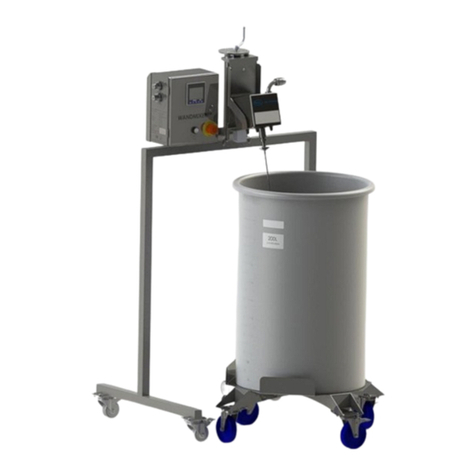
Pall
Pall Biotech RDUA007BT Instructions for use

Monmouth Scientific
Monmouth Scientific Ductaire TITAN DT1000 operating & maintenance manual

Excelitas Technologies
Excelitas Technologies X-Cite XYLIS XT700 Series user guide

Buchi
Buchi Lyovapor L-300 Guide for installation
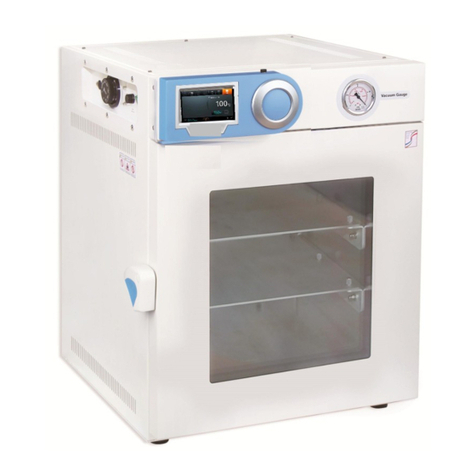
Daihan Scientific
Daihan Scientific ThermoStable SOV-20 user manual

AP&T
AP&T AP-DB1223 manual

Thermo Scientific
Thermo Scientific Lindberg/Blue M Mini-Mite TF55030 Installation and operating manual
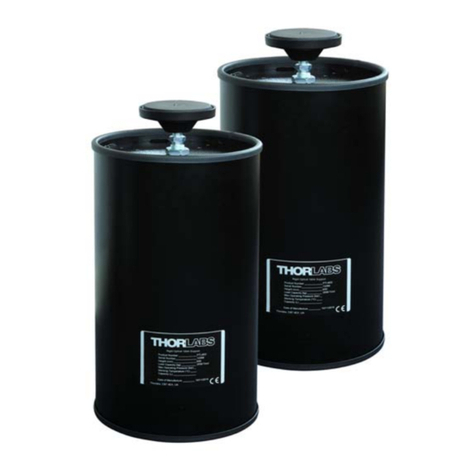
THORLABS
THORLABS PTL701 user guide
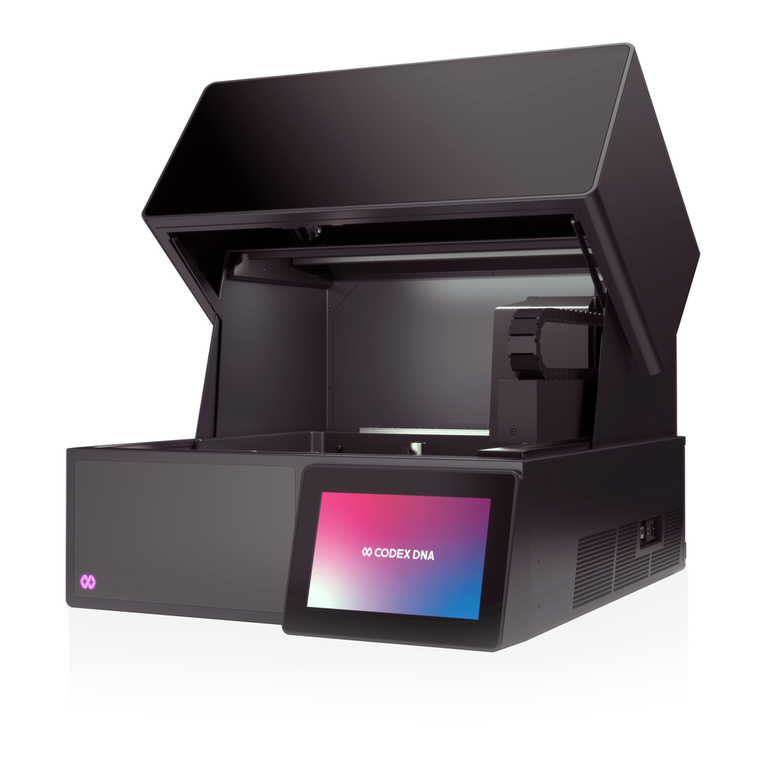
CODEX DNA
CODEX DNA BioXp 3250 user guide
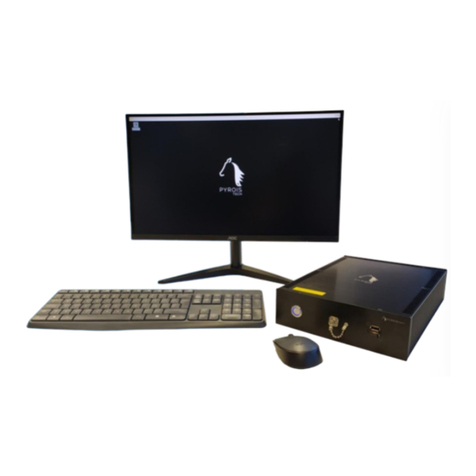
Pyroistech
Pyroistech MUSTANG manual

Roche
Roche MagNA lyser operating instructions
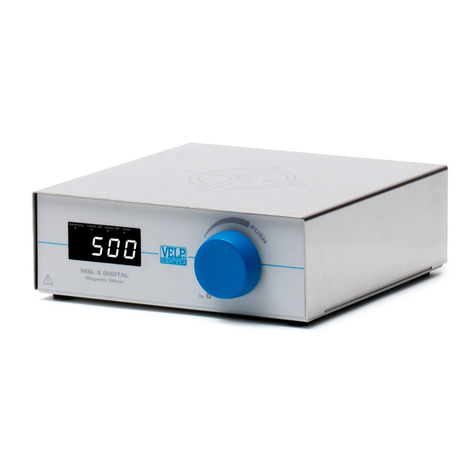
Velp Scientifica
Velp Scientifica MSL 8 DIGITAL instruction manual
